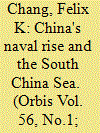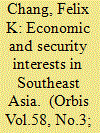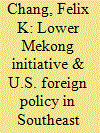| Srl | Item |
| 1 |
ID:
110157


|
|
|
|
|
| Publication |
2012.
|
| Summary/Abstract |
Over the last fifteen years, the steady rise of China's naval capabilities has received a level of attention unmatched since the Soviet navy's expansion following the Cuban Missile Crisis. Yet much of that attention has focused on what that rise has meant for Taiwan's security or a possible contest with the United States.1 But Beijing's seaward territorial concerns also reach far into the South China Sea. And it is there that the military balance has most swiftly swung in China's favor as a result of its modernization program. This article will examine not only how the military balance has shifted, but also what Southeast Asian countries, particularly Vietnam and the Philippines, could do to best preserve their territorial interests in response to that shift.
|
|
|
|
|
|
|
|
|
|
|
|
|
|
|
|
| 2 |
ID:
132555


|
|
|
|
|
| Publication |
2014.
|
| Summary/Abstract |
Despite worries that ASEAN is becoming weak, the organization remains as strong as it ever was, given the parameters of its design. Its member countries still tightly embrace the organization's principles, the "ASEAN way." But simple adherence to those principles can be problematic. ASEAN countries, whose national economic and political interests collide, often appeal to the same principles to back their positions. That tends to pull ASEAN in different directions. Great power policies, particularly those of China and the United States, now exacerbate the situation. At the same time, ASEAN's reliance on multilateral consensus has made it difficult to reconcile real differences among its member countries or develop unified regional responses. That can be seen in issues from the Xayaburi dam on the Mekong River to the South China Sea. The ease with which ASEAN's principles can come into conflict and its consensus-driven decision- making can become deadlocked clearly marks the limits of the "ASEAN way."
|
|
|
|
|
|
|
|
|
|
|
|
|
|
|
|
| 3 |
ID:
123292


|
|
|
|
|
| Publication |
2013.
|
| Summary/Abstract |
Begun in 2009, the Lower Mekong Initiative (LMI) is now America's foremost engagement vehicle on the Indochina peninsula of Southeast Asia. From the outset, its most concrete aim was to facilitate an integrated water management scheme for the lower Mekong River, where plans to harness the river's hydroelectric potential as a catalyst for economic development have clashed with more traditional uses of the river. But more broadly, the LMI also serves a larger American goal: to encourage regional cohesion and thereby slow the spread of Chinese influence. Whether the LMI achieves these aims largely depends on how successful its member countries- including the United States and all of Southeast Asia's riparian countries-are in putting to rest the differences over how best to balance the various uses of the Mekong River.
|
|
|
|
|
|
|
|
|
|
|
|
|
|
|
|